
August 23, 1991
I’ve been asked by quite a few fans why I quit the Star Trek comic book.
There are several answers to this, all of which were factors, all of which had to do with individuals at Paramount (but not Gene Roddenberry, for whom I continue to have a great deal of respect) and their actions in several instances:
1) A proposal for a six-issue time travel, which I rewrote three times, was ultimately rejected on the basis that it was “not simplistic enough” for Star Trek fans.
2) Changes are frequently insisted upon which I felt were detrimental to the stories, but reflected on me since my name was on the credits. For example, a sequence where a Klingon shot someone was deemed “too violent,” and changed (without my knowledge) to a Klingon bouncing an apple off someone’s head. Violent is out, but ludicrous is acceptable.
In eighteen months of writing Trek, precisely one story was printed with no changes–it appeared in issue #19 and, interestingly, was the only story submitted to Paramount without my name on it. Deduce from that what you will (the name under which it was submitted, by the way, was “Robert Bruce Banner.”)
Every single issue makes me wince at some point or other as lines of dialogue were cut, sequences diluted, and art changed, making the stories (except for #19) less than they could have been. The original “Kirk Trial” storyline submitted over two years ago had Kirk being tried (on the Klingon homeworld)…and found guilty. And the Enterprise command crew decides to rescue him, but the other 425 people on the ship are saying, “Wait a minute, we’re going against Starfleet orders, we can’t do that, we’ll be outlaws,” and there’s mutiny on the Enterprise, and…
Enough. You get the idea. It is the first and only time I’ve ever walked off a comic, and I did not do so until I decided that my continued presence was only going to continue to be detrimental to the series.
However, being a game individual, I signed on to do a dozen episode summaries for “Starlog’s” 25 Anniversary Trek magazine. Make them personal, I was told. Make them critical. Make them different. So I did. And then, by and large, they were gutted (via Paramount dictates…but again, not by Gene Roddenberry.)
This week and next week, I present them to you (which means if you’re not remotely interested in, or even hate, Trek, you can go straight to the little weird bio this week and next.) Some of the changes are minor (“The Cage”)–some are wholesale (“Piece of the Action”.) Comparisons, if you have the magazine, can be…educational.
THE CAGE
So many stories and anecdotes have arisen around this, the original pilot for “Star Trek,” that most fans can easily recite them:
“The Cage,” the episode that was rejected by NBC because it was “too cerebral” for the average viewership, underscoring just exactly what the programmers’ opinion of the TV audience was. (Of course, it should be put into historical context: The Number One show, at a time when the country was writhing in social change and elevated consciousness, was “The Beverly Hillbillies.”
“The Cage,” the episode that featured a green-skinned Susan Oliver, who was made progressively greener in make-up tests because a film processor was (unbeknownst to Roddenberry et al) restoring her skin to the “correct” color, and no one could figure out why she wasn’t photographing green.
“The Cage,” which engendered not an immediate slot on the NBC fall schedule, but instead another pilot commission and orders for changes such as that the satanic looking guy with the ears had to go (he didn’t) and the woman second-in-command had to be punted because, well, she was a woman (she was removed, although Gene then married her, which was better– as Majel Barrett has pointed out– than if they’d kept her as Number One and Gene had married Nimoy.)
But all of those stories aside, “The Cage”–with its story of Captain Pike and the original Enterprise crew, encountering the mind-controlling beings of Talos IV (or, as some unkind fans call them, the Bûŧŧ Hëádš)–indicates something intriguing. In the (network-despised) cerebral nature of the script, in the presence of someone named “Number One,” and with other touches and flourishes…we see that “The Cage” is a bit closer to “Star Trek: The Next Generation” than it is to the series that came as a result of the second pilot…the series that, by network dictates, accentuated action/adventure. Just think what might have happened if “The Cage” had sold.
Well, for one thing, Jeffrey Hunter might have lived and gone on to host “Rescue: 911″…
The Enemy Within
“The Enemy Within” is notable, even years later, for the incredible chances it takes with the hero of the series.
Captain Kirk, through a transporter malfunction, is split into two individuals…one good, one evil. That’s the simplistic summary of it, the easy description. “Evil twins” have been done to death, but the quality of this episode is that it didn’t stop there.
For the supposedly “evil” Kirk is far more than that. From him radiates the guts, the determination, the force that enables the Enterprise Captain to do a formidable, even murderous job. Without him, the “nice” Kirk falls apart before our eyes. One of the most moving moments in the history of Captain Kirk is watching him plead forlornly…as a stranded away team freezes on a planet below…”Someone…make the decision for me.”
There are, of course, plot holes you could drive a truck through. Why weren’t shuttlecrafts sent down to pick up the freezing landing party? Where did the extra mass to create a second Kirk come from?
But these did not detract from an agonizing episode as Kirk–on behalf of all of us–is forced to acknowledge and accept the nasty, dark side of himself that all of us try to shunt away. And he has to do it in front of his entire bridge crew. Yet they respect him for it all the more.
And Janice Rand has to look at him and know that in him lurks thoughts and capabilities of sexual assault–held in check only by his strong sense of morality. Hmmm. No wonder she left the ship shortly thereafter.
Trivia note: This is the first episode where McCoy declared, “He’s dead, Jim.”
Charlie X
Some years back my (then six-year-old) daughter, Shana, asked, “What’s your favorite Star Trek episode?”
“Charlie X,” I replied.
“What’s it about?” she asked.
To explain the full appeal of the episode to her would be difficult, I figured. After all, Star Trek’s answer to “Catcher in the Rye,” Charlie Evans is the (literally) ultimate disaffected teenager. Picked up by the Enterprise after being stranded for years by himself, Charlie has acquired formidable mental powers and wreaks total havok on the Enterprise.
All of his frustration, all of his anger, derives from the angst that cuts straight to the core of every teenager: No one understands me. No one likes me. Why can’t I fit in? But whereas the average teenager can only shake his hand in frustration, Charlie shakes up the entire starship. Eventually the Thasians, the beings who gave him his power and are capable of virtually anything (except, it would seem, noticing a ship orbiting their planet, something that a low-level NASA technician would be capable of detecting) show up and take Charlie back. What prevents it from being total deus ex machina is Charlie’s heart-wrenching pleas to remain with his fellow humans, including his primal scream of “I can’t even touch them!”
So, in answer to my daughter’s question, I said, “It’s about a boy who can do anything.”
“Can he bend his knees backwards?”
“What?” I asked.
“Can he bend his knees backwards like a flamingo?” asked Shana.
I smiled gamely and said, “No, he can do anything except bend his knees backwards like a flamingo.”
“Can he bend himself backwards so that the back of his head touches his feet?” she asked.
“No, he can’t do that either,” I said tiredly.
“Can he–”
“Shana, forget it!” I said. “It was my favorite episode. But it’s not anymore. Okay?”
And so it’s not.
The Menagerie
It’s not at all unusual for television episodes to run behind in production and, to make up for lost time, create a wraparound episode, or an album segment.
What happens is, they take previously filmed episodes, cobble them together with a few minutes of new footage (usually something to the effect of, “Hey, remember when we did such-and-such”) and you’ve got a new episode made for a fraction of the time and cost.
Trust Star Trek to do the old wraparound episode bit and make it one of the most memorable of the series, not to mention the only two-parter of the original run.
For reasons unknown, Spock kidnaps Captain Pike, his former commander who, thanks to a radiation accident, is unrecognizably scarred (conveniently so, since Pike is now played by Sean Kenney instead of Jeff Hunter.) He then hijacks the Enterprise and sets them on course for the forbidden Talos IV. A board of inquiry demands an explanation, which is provided since the Talosians apparently have a cassette copy of “The Cage” lying around that they project to the Enterprise.
In the world of Trek, nothing goes to waste–especially such an excellent story as the original, rejected pilot of “The Cage” which, apparently, audience’s cerebrums were able to handle just fine (despite network trepidation.) And certain the sultry dancing of Susan Oliver was worth waiting for. And as Captain Pike is then sent down to Talos IV, there to live in blissful pretendhood with Vina the cosmic babe, we are left to ponder such questions as reality versus fantasy, and just why didn’t Doctor McCoy notice that Number One looked a heck of a lot like Nurse Chapel.
Space Seed
The story goes that when the creators of “Star Trek II” were reviewing the original series to see what might provide grist for a movie, they stumbled upon this little one-episode wonder.
The Enterprise stumbles upon the Botany Bay, a sleeper ship that contains (in suspended animation) the tyrannical Khan Noonian Singh (lovingly played by Ricardo Montalban, dripping rich Corinthian leather from every pore), along with a number of his followers. All of them were world-conquerors, products of the Eugenics War of the 1990s (and my, aren’t we all looking forward to that this decade) and, once dethawed, set about conquering the Enterprise.
Curiously, the episode which inspired one of the best (if not the best) Trek movies, “The Wrath of Khan,” does not hold up well. The character of Lieutenant Marla McGivers, who is so impressed by Khan that she jettisons her loyalties to the Enterprise, is positively embarrassing. And the climactic battle between Kirk and Khan in the engine room (the site of so many fights that it’s amazing they didn’t just outfit it with a permanent boxing ring and mats) features incredibly noticeable stunt man switches, rivalled in obviousness only by “Courtmartial.” What it does not feature is Mister Chekov, whom Khan inexplicably recognizes in the film. Superior intellect indeed.
But “Space Seed” is memorable for Montalban, and also for one of McCoy’s best series moments: Khan, having revived prematurely from his deep-freeze, gets the drop on the physician and holds a knife to his throat, demanding answers. And McCoy, with extraordinary sang-froid, not only does not answer the questions but, instead, gives Khan tips on the most efficient way to slit someone’s throat. Khan is suitably impressed. So are we. Talk about bedside manner.
Peter David, writer of stuff, is puzzled over the brouhaha regarding Paul Reubens. First off, there’s this business about innocent until proven guilty. Second off, even if it’s guilty, it’s not like he was at a matinee showing of “The Rocketeer.” And third off, why is it that no one is declaring that Annette Bening, bearing a child out of wedlock, will never work in show business again, but they say that of Reubens who is alleged to have committed a victimless crime involving self-gratification? Considering some of the major jerks working in Hollywood, this particular “jerk” is pretty…well…pee-wee.
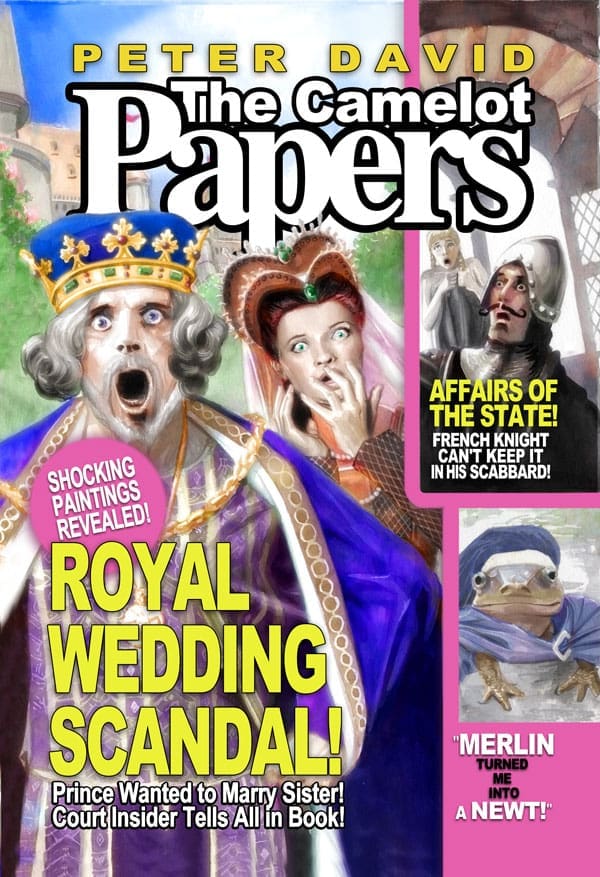
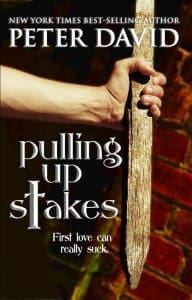
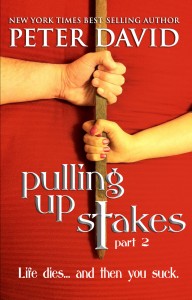
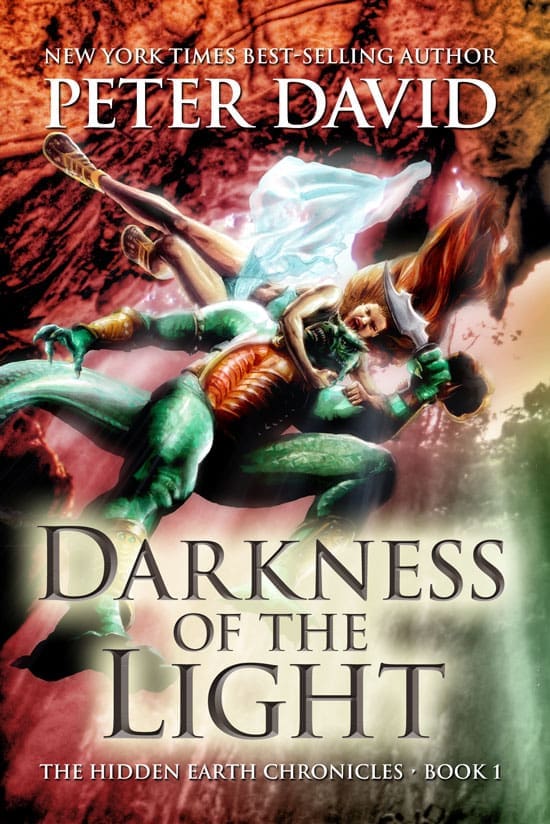
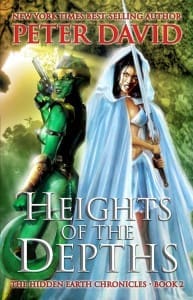
Anybody else get an odd feeling whenever a ‘major’ event from some bit of sci-fi that had been slated for a particular date doesn’t happen, despite that date zipping by?
Like the launch of the Jupiter 7. Or the moon blasting out of orbit. Or Judgement Day.
…actually, I suppose we are better off without those. Wouldn’t want those giant talking carrots finding their way to Earth, now would we…
Neat, so THAT’S where the dialogue from Q-In-Law comes from.
So, in answer to my daughter’s question, I said, “It’s about a boy who can do anything.”
“Can he bend his knees backwards?”
“What?” I asked.
“Can he bend his knees backwards like a flamingo?” asked Shana.
I smiled gamely and said, “No, he can do anything except bend his knees backwards like a flamingo.”
“Can he bend himself backwards so that the back of his head touches his feet?” she asked.
“No, he can’t do that either,” I said tiredly.
“Can he–“
“Shana, forget it!” I said. “It was my favorite episode. But it’s not anymore. Okay?”
And so it’s not.
OHHHHHHHH!!! SO THAT’s where that brilliant exchange from, what was it, Q-In Law!?, Came from!!!
How hilarious!
re: the weird little bio:
If you were one of the citizens of that little Florida town who was robbed, raped, assaulted, or otherwise victimized by a criminal that night, wouldn’t you be glad to know that there wasn’t a cop there to stop it, bacause he was one of the team arresting Pee Wee Herman at a pørņ theater?
About the W.L.B. and Paul Reubens…the first nasty thought was that although he wasn’t watching “The Rocketeer,” he was certainly launching something.
Second is the curious question as to whether Reubens was being targeted for arrest because someone simply hated his guts. That would be a very far-fetched idea, that a cop would be directed to follow him to a pørņ theatre and watch him in the hope he was doing something illegal. It’s also kind of paranoid. Although, it becomes more likely if you’ve seen some of Reuben’s performances and were enraged by them.
Third, this was something done in a pørņ theatre that would have not been actionable if Reubens had done it while watching a pørņ video at home. The only reason for doing it in a pørņ theatre would be the “danger” of doing something naughty in the proximity of other human beings. Which, to me, is pretty pathetic, since as a public performer he has all kinds of opportunities to display himself before others. (And yes, if he really wanted to, he could display himself in “that way” in a movie or stage performance. It would make his career radically different, but possibly more interesting than the stuff he’d been doing for about a decade at that point.)
I think my brain literally broke when I read the bit of dialogue surrounding the “boy who can do anything.” Flashing back on books I’ve read far too many times for my own sanity is always such fun – thanks much for the story of how that exchange came to be!
As for the rest… bureaucracy and corprorations will always weed out the best ideas. That’s the nature of the beast.
As for the rest… bureaucracy and corprorations will always weed out the best ideas. That’s the nature of the beast.
Well, yeah…but that wasn’t the case this time. More like a fan getting his innermot wishes granted…and how fortunate we all are that it doesn’t happen that often….
Hey, PAD, or anyone for that matter…
anyone see Jon Stewart on Crossfire? He really blasted those guys for being political stooges, and it was truly a shining moment for the everyman. Go find a transcript if you haven’t seen it or read it…
At one point Tucker Carson told Jon he wasn’t being funny enough, so Jon said “I’m not your monkey!”
Seriously, go read it.
Incidentally, TV Guide ran that Pee Wee Herman story under the headline “Sticking up for Pee Wee Herman”. Not an urban legend; I saw it myself.
Kurt.
Check out ifilm.com. It has the whole interview.
Is there any chance for you to post that Star Trek time travel that you rewrote three times? I’m sure we would all love to see your handiwork, Mr. David.
He could reshape bits of reality. If his power could affect himself as well, then, sure, Charlie could probably do those things once he’d willed himself to.
I remember the “Trial of Kirk” storyline from that series. In hindsight, one could entertain the possibility that Paramount may have rejected certain aspects of that storyline from the comics so that they could be swiped for “Star Trek VI: The Underdiscovered Country.”
Something to consider, PAD. Maybe you could sue for royalties. ;>
What I want to know is why more people don’t say “Yeah, I liked ‘Charlie X’…especially when I read ‘Stranger In A Strange Land’.
My favorite ST:TOS has to be the early one where Kirk’s best buddy gets the power of a god and just wants one planet so that he can create eden and Kirk is not only forced to save his ship, not only forced to kill his best friend, but takes a rifle to a fight against a guy who can do anything, talk about stacking the deck!
Sweet Stuff